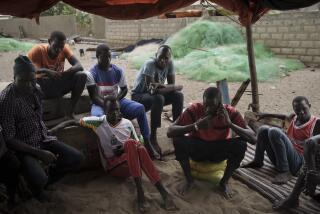Saving Grace Comes to Child Adrift at Sea
- Share via
MIAMI — The meaning of Thanksgiving seemed even more poignant Thursday--especially for tens of thousands of Cuban exiles--after fishermen plucked from the sea a 5-year-old boy found clinging to an inflated inner tube.
The child--alone, severely dehydrated and slipping in and out of consciousness--was one of 14 people believed to have left Cuba on Sunday aboard a 17-foot boat that sank in the Gulf Stream two days ago.
Eleven of the 14--including the boy’s mother--are missing and believed drowned, according to the U.S. Coast Guard.
Two other Cubans--a 23-year-old woman and a 33-year-old man--were rescued in a second inner tube off the shore of Key Biscayne a short time before the boy was spotted, according to the Coast Guard. They were hospitalized in Miami in critical condition.
“They were in terrible condition,” said Metro-Dade Det. Ed Munn. “They were obviously beaten up by the water and conditions.”
The boy was discovered about 10 a.m. Thursday as he drifted northward about 20 miles northeast of Miami.
“We thought someone had tied a dummy to a raft,” boater Sam Ciancio told Miami CBS affiliate WFOR-TV. “I dove into the water after the kid, and the kid was just shaking.”
The anglers called the Coast Guard, which responded with a cutter that rushed the child to shore in Fort Lauderdale. By ambulance, he was taken to Memorial Regional Hospital in Hollywood, where he was listed in stable condition in the pediatric intensive care unit.
“He is alert, talkative, and he even had a Thanksgiving plate--some turkey and mashed potatoes,” said hospital spokeswoman Lauri Brunelli. “But he didn’t like the stuffing--he spit that out.”
Also found at sea Thursday was the body of an elderly woman believed to have been among the Cuban migrants.
Three Coast Guard helicopters and a plane from the exile group Brothers to the Rescue continued to search for other survivors Thursday in an area that stretched from Islamorada in the Florida Keys to Boca Raton.
Once ashore, the couple rescued off Key Biscayne told police that seven people aboard the boat drowned Tuesday when the vessel sank two days after the group left the north coast of Cuba near Cardenas, about 200 miles due south of Miami.
The remaining seven, including the boy, the only child among the migrants, held tightly to the two inner tubes that were being towed behind the boat. The boy reportedly told the Coast Guard that he left Cuba with his mother and another woman.
“Here we are on Thanksgiving Day, when most Americans are sitting back and reflecting on what we’re thankful for, and these migrants are making a desperate--although illegal--effort to get here,” said Coast Guard Petty Officer Scott Carr. “It’s very sad, very tragic.”
Although the child’s mother apparently perished, by noon several other relatives--aunts, uncles and cousins--already living in South Florida had gathered at his bedside. Brunelli said family members indicated that they knew the boy was among those attempting to make the risky crossing from Cuba this week.
The tragedy of the deaths, and the resiliency and rescue of the child, immediately became the leading topic of discussion through the holiday afternoon on Miami’s talk radio shows, especially those in Spanish. On WQBA, host Ninoska Perez took several calls from Cuban Americans who recounted their own arrivals, by boat or through third countries.
“Everyone can identify with this sad story,” Perez said. “It’s like the Pilgrims. They were coming here to obtain the same freedom.”
The exodus from communist Cuba and the regime of Fidel Castro has had an irregular ebb and flow over the last 40 years, but it has never stopped. Few Cubans arrive in South Florida now by raft or inner tube, however, as did many of the 35,000 migrants who crossed the Florida Straits in flimsy homemade vessels during the summer of 1994.
Most Cubans who enter the U.S. illegally now--and they arrive every week--come in the boats of smugglers, or show up without visas on flights arriving at Miami International Airport.
Once on shore, Cubans are paroled into the community. Under an agreement between the U.S. and Cuba that ended the 1994 rafter crisis, only those migrants interdicted at sea can be repatriated to the island.
This year, 1,261 Cubans have been interdicted at sea, compared with 1,047 for all of 1998. Most of those migrants have been returned to Cuba.
Ciancio, drifting offshore while fishing for dolphin, said it was sheer luck that led his boat to cross paths with the boy in the inner tube. “This is the best Thanksgiving I will ever have,” he told television reporters. “You can’t have one better than this.”
More to Read
Sign up for Essential California
The most important California stories and recommendations in your inbox every morning.
You may occasionally receive promotional content from the Los Angeles Times.













